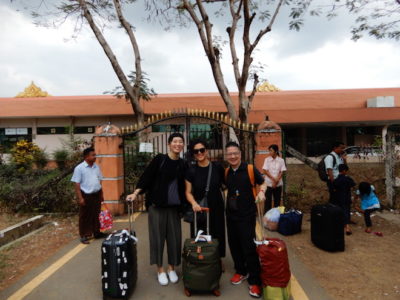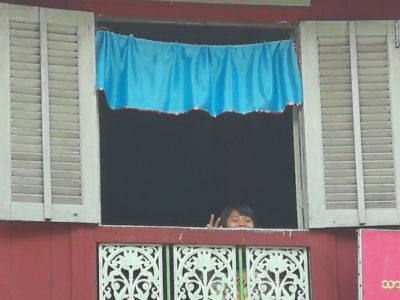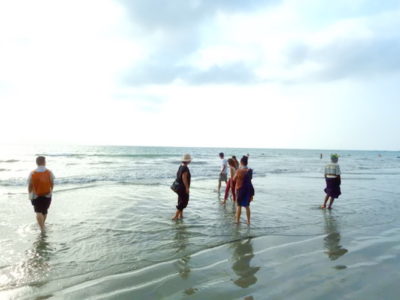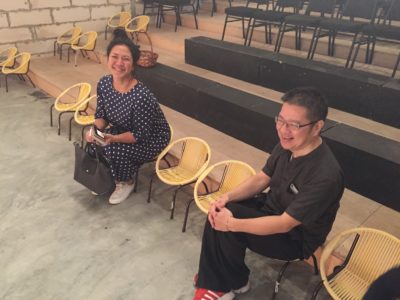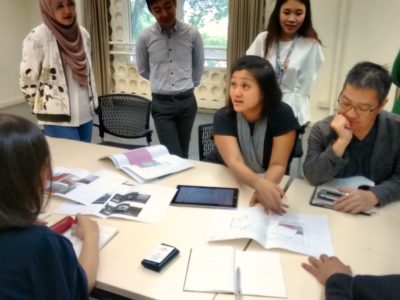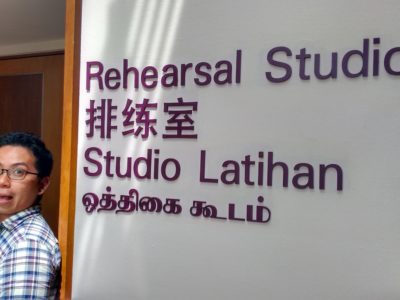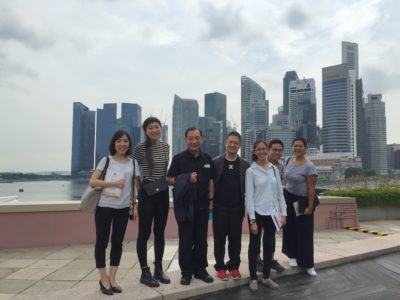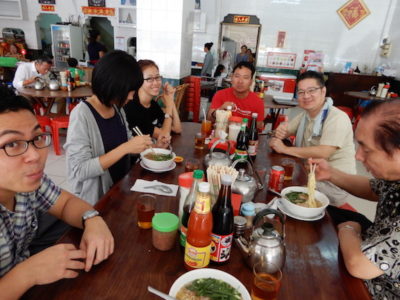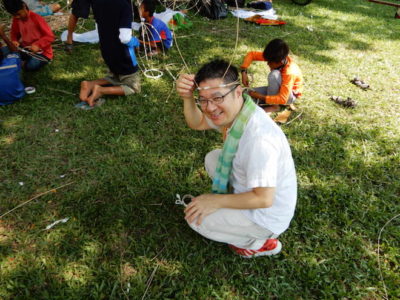Home » Research Visit Reports » Nao Miyauchi
We conducted the second TYA research trip to Cambodia from 6th to 11th February 2017, followed by the visit to Singapore and Kuala Lumpur in November 2016. Although it was a tight schedule visiting three cities; Siem Reap, Battambang and Phnom Penh in only four days, this was a very fruitful visit with huge support of Mr Dara Huot and Ms Momoko Ikeuchi from Phare, the Cambodian Circus who coordinated the trip. I would like to express appreciation here again.
Unlike the trip to Singapore and Kuala Lumpur, we focused on investigating how performing art contributes to young people's learning, holding my expectation that recognition of "TYA=Theatre for Young Audience" as a genre would be very low. I noticed that there has been a strong influence by Khmer Rouge and it is significantly important to understand its history in Cambodia when considering art and education especially. With my lack of knowledge of the historical background in Cambodia, I achieved a deeper understanding through conversation with people there. In this report I would like to summarise my experience in each city, overall reflection and prospect. Significant areas of research that emerged were;
1) relationships between traditional art and contemporary art
2) art projects by international NGO groups
3) use of art as a tool to approach social subject matters within Cambodian heritage
Siem Reap, the first stop is the biggest tourist destination in Cambodia where Angkor Wat famously exists. We went out on the arrival night and felt that it was like a theme park. Western tourists were drinking at the open bars alongside the colourful neon lights and loud music from every direction. Cambodian people seemed to work as either waiting servers or tuk tuk drivers, which confused me where I was. Until the meeting with artists next day had I realised that there is a deep interrelationship between the tourism industry in Siem Reap (and also other cities) and performing arts.
In Cambodia there is little culture that people spend money to watch their traditional performing art, instead it is wealthy people's business (e.g. the local rich people organise performance shows on occasion such as celebrations) and many traditional dancers hold performances at tourist locations for foreign tourists such as hotels. On the one hand, we might think that there are enough performance opportunities and financial resources, but in fact there are many unfavourable conditions in the wages for performers and performance environment. Furthermore, according to Bob Ruijzendaal from New Cambodian Artists these artists who only have hotels as a performing space find it difficult to keep their motivation high due to the lack of opportunity to meet new artists and forms of art since they repeat the same show in the same place over and over. However, both Phare and Bambu Stage dedicate to young generation whilst securing financial stability targeting the tourists. Especially Phare which acts as a social enterprise, seems to be perceived as an ideal model by many companies we visited. In Siem Reap, we had an opportunity to watch Phare's brand new work, "Same, Same But Different". While Phare tells Cambodian stories through circus, this piece portrays the foreign tourists from the perspective of Cambodian people. Although it was a circus based performance, mostly comical and invited the audience's laughter, this production was quite sharp and political with subtle cynical twists, considering that most of the audience would be foreign tourists.
Another company we visited in Siem Reap was Giant Puppet Parade. We interviewed the company surrounded by chatting and laughing children who were making puppets for an upcoming event in two weeks time. Their parade, which is the 11th anniversary this year and happens in the centre of Siem Reap, shows giant puppets created by both Cambodian and international volunteers, artists and children who are invited by NGO which particularly acts for children in unfortunate circumstances. It started with the prospect to share the power of art with children since the school curriculum does not include art subject in Cambodia. Although the parade began as a small event, it developed into a project that represents the culture in Siem Reap, accessed by almost 20,000 people including the locals and tourists. Inspiring confidence, pride and responsibility of the community for young participants, their families and locals, it became a platform to promote art to wider audiences with growing number of sponsorships by domestic companies and groups in recent years. We learned that the Giant Puppet Parade is one of significant TYA models in Cambodia approaching children and social matters through art form.
Battambang where we visited next is a base of Phare whose success seems to be a model for many companies. Phare as a social enterprise performs almost every day all year around in Siem Reap and their profit is used for management of the school Phare Ponleu Selpak in Battambang. In Cambodia while there is hardly any government funding in the art field, many art projects, supported by foreign NGO with no guarantee for a long term support, often tend to end in a few years. And Phare demonstrated a model that is possibly sustainable without relying on outside sources, which is a concern among many companies. Although they mentioned that the profit is far from being sufficient, their model, in which Phare circus offers employment to performers who trained at the school, uses the profit for managing the school and continues to help next generation grow. It seems to be a fair management approach reflecting the situation in Cambodia. At the same time, it was very inspirational to me because of our tendency to be dependent on outsource funding.
Phare Ponleu Selpak provides children free access to training courses on circus, music, theatre, dance, graphic design and animation outside of the normal school schedule which is either morning or afternoon in Cambodia. As I mentioned there is no art subject in the public school curriculum in Cambodia, at this school children can take free courses in which they can learn skills that possibly lead to work in the future as well as enjoy art making. Especially with the circus course, the students have performance opportunities in front of the audience in the circus tent set up in the school for a few times a week. After tickets holders take their seats, empty seats are offered to the students and local people for free. When we saw the show, the auditorium became full with half local children and young people and half those who purchased the tickets. I got the impression that the school is genuinely open for both the school children and local people. It is extremely exciting to imagine what sort of production would be created from Battambang which is growing as an art village with the school involving most of the local people and children.
We arrived at our last destination, Phnom Penh the capital after almost 7 hours drive from Battambang. Firstly we traveled to Cambodian Living Arts(CLA), a representative art group of Cambodia amidst the hustle and bustle of the capital city. Here we encountered CLA and its partner, Krousar Thmey which is dedicated to working with children with disabilities as well as Epic Arts, an art group that also works with similar learners in Kampot. Sadly having not enough time to exchange much information, we managed to briefly touch on some topics such as new approaches to traditional art forms, art projects in remote areas and activities with young people with disabilities. While about 7 percents of the population in Cambodia are people with disabilities, discrimination and isolation have become the social issues. Epic Arts aims to raise confidence in those who live with disabilities by finding their potentials through art activities in order for them to live as an integrated member of the society. To allow for authentic expression, Epic Arts applies methods from contemporary dance and theatre. Also CLA, with Krousar Thmey deals with social issues by making works that intentionally don't follow conventional rules, yet using Yike theatre, the traditional performing art form as a base in order to be more accessible and easier to understand for the current audience. However CLA's projects are so broad that we couldn't capture the whole, I learned that they engage art activities with people living in Cambodia using the traditional performance as the base. Having tourists as their main audience, they seem to succeed in gaining the financial resource and introducing aspects of traditional Cambodian culture.
Meta House, equivalent to Goethe Centre is the first institution that provides a theatre in education program to schools cooperating with the Ministry of Education since 2015 in Cambodia. Whilst the students tend to take passive roles alongside teachers in Cambodia, it is marked that this program has been very successful, which visits schools nationally and encourages students to use theatre as a tool to express themselves, especially dealing with the social issues around young people with Cambodian facilitators and actors. The first production from 2015 chose Khmer Rouge as a theme due to the fact that young people lacked the knowledge and interest in their own country's history. Therefore this piece was made hoping for students to have a chance to learn that their current social situation has been influenced by the history and it is inevitable to understand the past to think about the future. In 2016, a new team was formed and made it possible to visit more schools with an intention to expand further. However according to the director, Nico Mesterharm, it has been the most difficult to persuade school head masters to corporate in order to carry out the program. Most importantly they need to visit school and speak in person because the schools tend to dismiss the official letter from the Ministry of Education. Meta House mentioned that the fact they are Goethe Centre (official partner), rather than a branch of Geothe Institute which directors are sent from Germany and the main purpose is cultural promotion of Germany, made it possible to present more flexible programmes and space to discuss the social and political issues from more neutral position and conduct activities that reflect contemporary Cambodia.
Since CLA has long been lobbying for the government to include art subjects to the school curriculum in Cambodia, for the first time CLA started a pilot program of art education in high schools in Phnom Penh. Then Phare also introduced an art education in high schools in Battambang and Meta House is now aiming to follow suit in the near future. The art projects within Cambodia have been made possible with support by UNESCO and international NGO's. Since UNESCO changed the agenda on supporting after Cambodia became a middle-profit country, there has been pressure on the government in order to continue the art projects without relying on the outside resources. At the same time, there has been growing interests in connecting domestic art groups, and Phare is planning to create a network amongst Cambodian art groups nowadays. If the network is fully formed, it would make it easier and possible for Asian colleagues like us to exchange information and start various projects with Cambodian artists
Tiny Toones provides the educational programs at no cost for those who drop out of the public educational system in order for them to return to the school. They support around 100 children with the age range from 5 to 18 years old who can attend the general subjects which are usually taught at the public schools such as Khmer, English and math, as well as creative classes like dance, music and art. KK, the founder originally began teaching dance everyday to several children at home and the number of children expanded to about 70, which made him realise how many children had problems going to the public schools. And Tiny Toones was formed to assist these children to adapt in the society. They accept all the children in need from the local areas with a free lift from home. They run Cool Lounge, a bar restaurant with a dance studio as a social enterprise because they found it difficult to rely only on donations funding and fundraising events. They haven't gained sustainable profit yet however they aim to gain continuous financial resources from the restaurant. They tour USA and Europe with a narrative hip hop dance production whose theme is recent social issues (violence and drugs) relevant to the young audience.
Overall I had the impression that one of the themes is how to create a theatre piece that attracts current audiences whilst respecting the traditions. For example, Sophiline Arts Ensemble from Phnom Penh employs contemporary dance methods into making of traditional dance piece and Sovanna Phuket Arts integrates the use of dance and mask with traditional shadow puppet show for audience. There are many companies that apply unconventional contemporary dance and theatre methods in order to realise free styles of expression. On the other hand, there seems concerns with how people adapt in changing climate of performing arts since the traditional art has been ingrained in their life. Especially since the field of contemporary theatre is recognised less than that of dance, there seemed neither theatre spaces nor jobs for actors even if they are trained professionally. However a young theatre artist we met through CLA mentioned that although there are very small and limited number of jobs in contemporary theatre, if there is a performance, it sells out with young audiences. This appears to be a great turning point in Cambodian art scene itself with growing attention to the contemporary theatre works and practice of purchasing theatre tickets among the young.
Even though we didn't meet companies whose activities are called as TYA in Cambodia, they share the exact same root with what we call TYA using theatre very effectively as a tool to call out to the society and raise awareness, dealing with young person's social issues. Those who tend to consider the well known fairly tales and theatre works that have strong emphasis on entertainment would learn a lot from these approaches applied in Cambodia. And most of the audiences are young without categorising as "young people" due to the fact that 70% of the population is under 30. If a company create a theatre piece for young people, it naturally reflects the society they live in and inevitably becomes equivalent to works of TYA. As Shhort from Tiny Toones pointed out that young generation now face new social challenges and Nico from Meta House mentioned that the young people have little interest in their history, Cambodia is experiencing a dramatic social transformation which puts increasing pressure on young people. Therefore it is extremely important to connect and cooperate with colleagues who work for young people through theatre performance within Asia.
I argue that what we can do as TYA network program Asia is to offer opportunities for artists to generate creative dialogue beyond regions and nations. For example, if a theme is set as "drug addiction among young", it would take different approach, process of making, use of images and language and style of theatre depending on the culture the artist practices. I would say that it is a very rare opportunity to have a space where artists connect with their peers and collaborate in order to broaden their artistic perspectives within Asia where mobility of art works and artists is not as flexible as western models. Although recognition of the field of TYA (or the terminology) itself is limited in many regions in South East Asia, there seems to be plenty to share about actual project contents and visions. I believe that it would be meaningful to start up a real creative exchange before imposing TYA as a category.




